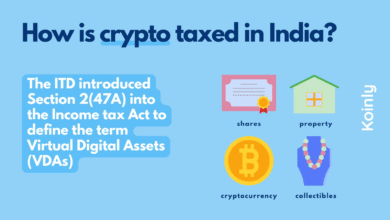Ethereum Unstaking: Cathie Wood’s Insight on Institutional Shift

Ethereum unstaking has emerged as a pivotal trend in the crypto landscape, capturing the attention of institutional investors and influencing market dynamics. With a substantial volume of ETH being released from staking, Ark Invest CEO Cathie Wood points to the implications for liquidity and investment strategies among these market players. As traditional financial instruments become more appealing, crypto-focused entities are reconsidering their positions in favor of staking alternatives that promise enhanced returns. The atmosphere is ripe for a liquidity shift, with institutions actively seeking new ways to engage with Ethereum and maximize their investment potential. By examining these shifts, it becomes clear that Ethereum unstaking is a significant indicator of evolving investment philosophies in the digital asset realm, especially among influential firms like Ark Invest.
The recent developments surrounding the withdrawal of staked Ethereum have triggered conversations about the broader implications for crypto investors. This trend, often referred to as Ethereum unstaking, reflects a transition in how significant players in the market are approaching their investment strategies. Cathie Wood of Ark Invest points out that this movement isn’t merely about releasing funds but also indicates a strategic pivot towards more liquid investment options. As institutional investors weigh their choices, they are exploring approaches that intertwine conventional equity investments with digital asset liquidity. This shift could redefine engagement within the cryptocurrency space, highlighting a proactive response to market incentives and evolving financial landscapes.
Understanding the Surge in Ethereum Unstaking
The recent surge in Ethereum unstaking has become a focal point for institutional investors seeking flexibility and higher returns. With the backdrop of increasing staking volumes, it is evident that a significant shift is taking place within the investment community. As Ark Invest CEO Cathie Wood highlights, institutional players are reevaluating their strategies, moving towards liquidity-focused investments. This trend is not merely a reaction to market fluctuations; it represents a strategic pivot that allows these investors to take advantage of current financial instruments tied to digital assets, particularly Ethereum.
Moreover, this increase in unstaking activities reflects broader market dynamics where retail investors, incentivized by attractive offers like Robinhood’s 2% match for crypto transfers, are drawn into the ecosystem. The unlock of staked ETH is seen as a critical moment where both institutional and retail investors can maneuver within a landscape that is rapidly evolving, pushing towards innovative staking alternatives and equity-based strategies. This could potentially redefine how Ethereum is viewed not only as a cryptocurrency but as a viable asset class offering institutional-grade investment solutions.
Cathie Wood’s Insights on Institutional Investors and Ethereum
Cathie Wood’s perspective on the relationship between Ethereum unstaking and institutional investor strategies sheds light on how cryptocurrency investments are adapting to global financial trends. As stakeholders ranging from venture capitalists to hedge funds explore the benefits of transferring staked ETH into Treasury companies, it becomes clear that there is a tactical awareness of maximizing yields in both traditional and crypto markets. Wood’s examples of Microstrategy and Bitmine Immersion Technologies underscore a burgeoning trend of corporations integrating cryptocurrency into their treasury management, highlighting a merging of equities and digital assets.
This strategic shift also aligns with the increased demand for liquidity, a theme that has emerged prominently in discussions among institutional investors. By leveraging Ethereum stake releases, these firms can allocate resources more freely, potentially doubling their investments after the lock-up periods conclude. The momentum behind this trend is further supported by the understanding that these institutional players are looking to ensure their cryptocurrency holdings are not only secure but also easily tradable within the frameworks of traditional finance, making Ethereum an appealing addition to diversified portfolios.
The Evolution of Staking Alternatives in Ethereum
As Ethereum continues to evolve, the discussion around staking alternatives has garnered substantial attention, particularly among institutional investors. With the growing discontent with traditional staking yields, many are exploring various opportunities that allow for greater flexibility and potential returns. While Ethereum staking has facilitated significant investor interest, the reality is that not all stakeholders are content with the current structure of lockups and yield expectations. Instead, they are looking toward alternative methods to derive value from their investments while maintaining liquidity.
Moreover, the concept of staking alternatives includes varied financial instruments that can work in tandem with existing Ethereum holdings. Institutions are increasingly driven to seek products that provide better abstraction and opportunities for growth, which could involve derivatives or equity exposure to crypto assets. With venture capitalists and institutional players considering these staking alternatives, the Ethereum landscape is anticipated to witness further enrichment, promoting more robust participation from both retail and institutional investors in the cryptocurrency space.
Institutional Shift Towards Equity-Based Investments
The pivot of institutional investors towards equity-based investments marks a significant trend in the cryptocurrency landscape. This shift has been amplified by leaders like Cathie Wood, who illuminate the benefits of equity exposure to digital assets such as Ethereum. These equity pathways provide traditional finance professionals the ability to navigate the world of cryptocurrencies without necessitating direct custody of tokens. This model enhances accessibility for institutional players while reinforcing the legitimacy of cryptocurrencies in broader investment strategies.
Institutional investors are increasingly attracted to Ethereum not only for its scalability and utility but also for how it can be integrated back into existing financial frameworks. By incorporating Ethereum into their portfolios through equity routes like those offered by established companies, investors can leverage the robust functionalities of DeFi and the potential for growth in the crypto space. As Ark Invest’s insights reveal, the momentum gained from this realignment showcases a new era for institutional investment in cryptocurrencies, solidifying their role as a significant driving force in the market.
Liquidity Concerns and Ethereum Unstaking Strategies
Liquidity concerns are paramount for institutional investors as they navigate the evolving landscape of Ethereum unstaking strategies. Cathie Wood points out that as lockup periods end, many investors are reassessing their positions and looking at ways to capitalize on their assets. The urge to unstick Ethereum staked previously speaks to the need for adaptability in today’s fast-paced financial environment. By unlocking staked assets, institutions are enabling themselves to respond more dynamically to market conditions, ensuring they can optimize their portfolios.
Furthermore, the liquidity shift that Ethereum is experiencing may not only influence institutional strategies but also potentially elevate the overall ecosystem. As more ETH enters circulation post-unstaking, it can prompt price adjustments and enhance trading volumes, creating an environment ripe for investment. This transformation highlights the importance of institutional interest in fostering overall liquidity within the Ethereum market, propelling it closer to mainstream financial acceptance and encouraging greater adoption among institutional investors and retail participants alike.
Why Ethereum Staking Remains Compelling Despite Trends
Despite the prevailing trends in Ethereum unstaking, there remains a strong case for staking Ethereum as a worthwhile investment strategy. The underlying mechanics of Ethereum staking offer participants the opportunity to earn rewards simply for holding their assets, which is a powerful incentive in itself. Even as institutional players explore alternative routes, the fundamental benefits of staking, such as contributing to network security and earning passive income, cannot be overlooked. These aspects remain compelling for both individual and institutional investors alike.
Moreover, alongside the surge of unstaking activities, the Ethereum staking ecosystem is maturing. Platforms are increasingly providing better yields and features, enhancing the attractiveness of staking as a long-term strategy. As Ethereum transitions to a Proof-of-Stake model, innovations and improvements in staking protocols are likely to further interest institutional and retail investors, creating an environment where both staking and unstaking can coexist, allowing participants to choose strategies that align with their investment goals.
The Role of Venture Capitalists in Ethereum’s Future
Venture capitalists (VCs) are playing a crucial role in shaping the future of Ethereum by driving innovation and facilitating investment strategies that align with the rapidly changing market landscape. As prominent figures in the venture community embrace Ethereum and explore its potential, they are pivotal in what could become a transformative era for cryptocurrency investment. Their investments are not just financial; VCs are also heavily involved in cultivating startup ecosystems and blockchain projects that are leveraging Ethereum for endless applications.
By strategically positioning capital in both established and emerging ventures related to Ethereum, VCs are effectively supporting an ecosystem that promotes utility and liquidity. Their recognition of Ethereum as a robust platform is indicative of the growing institutional interest, as these investors seek to ensure they remain at the forefront of technological advancements within the financial sector. As a result, the interplay between venture capital investment and Ethereum will continue to drive narratives around staking, liquidity, and the evolution of crypto markets.
Analyzing the Impact of Ethereum on Institutional Investment
The impact of Ethereum on the landscape of institutional investment is undeniable, as it reshapes the way these entities interact with digital assets. As institutional investors, led by insights from figures like Cathie Wood, begin to view Ethereum as a legitimate equity-like investment, they are more inclined to incorporate it into diversified portfolios. This shift is partly driven by Ethereum’s extensive use cases and its utility in various sectors, providing institutional players with confidence in its long-term viability.
Additionally, the influence of Ethereum’s scalability and technology on investment strategies cannot be overlooked. As institutional players seek to mitigate risks while maximizing returns, their engagement with Ethereum reflects a broader transition toward digital assets. This progressive acceptance is likely to usher in significant liquidity changes, allowing Ethereum to maintain a pivotal position within an ever-evolving financial landscape, ultimately elevating its status among institutional investors.
Future Predictions for Ethereum and Unstaking Trends
Predicting the future of Ethereum amidst the ongoing trends of unstaking reveals a fascinating landscape characterized by rapid evolution and resilience. As more institutional investors partake in the unstaking cycle, the implications are profound: currency liquidity will increase, which can lead to both positive and negative market effects depending on broader economic conditions. This creates a scenario where Ethereum, alongside other cryptocurrencies, must navigate the complexities inherent in financial markets.
Moreover, as Ethereum matures, future predictions suggest that staking and unstaking will continue to coexist, allowing investors to choose strategies that align with their fiscal goals. Innovations in yield generation and marketing tactics aimed at attracting institutional investment will likely unfold. As Cathie Wood aptly notes, Ethereum’s position as a key asset will endure, ensuring that it remains a focal point in portfolio allocation discussions across the investment landscape.
Frequently Asked Questions
What is Ethereum unstaking and why is it trending now?
Ethereum unstaking refers to the process of withdrawing staked ETH from the Ethereum 2.0 network. Recently, this process has surged, as noted by Ark Invest CEO Cathie Wood, due to shifts among institutional investors seeking equity-based investments and liquidity alternatives in response to increased incentives for offloading staked assets.
How does Ethereum unstaking relate to institutional investors and crypto?
Ethereum unstaking is increasingly relevant to institutional investors as they look for more flexible investment opportunities. As highlighted by Cathie Wood from Ark Invest, many institutional players are moving away from traditional staking models toward strategies that enhance liquidity and provide easier access to capital, particularly in light of recent staking alternatives emerging in the market.
What are some Ethereum staking alternatives being discussed?
With the rise of Ethereum unstaking, alternatives to traditional staking models have gained attention. For instance, institutional investors are exploring Treasury companies, like those mentioned by Cathie Wood, which allow for exposure to ETH through equity investments rather than direct staking, thus enhancing liquidity and potentially increasing returns.
Why is there a liquidity shift happening in Ethereum unstaking?
There is a liquidity shift in Ethereum unstaking as institutional investors are increasingly transitioning their staked ETH into more liquid financial instruments. This shift aligns with Cathie Wood’s insights on the market, where investors are taking advantage of the expiration of lockup periods to access their assets, driven by incentives and a desire to optimize their returns.
What role does Cathie Wood play in understanding Ethereum unstaking trends?
Cathie Wood, the CEO of Ark Invest, provides valuable insights into the trends of Ethereum unstaking by connecting it to broader market dynamics and institutional strategies. Her observations shed light on how Ethereum’s staking landscape is evolving, indicating a move towards equity-based models and liquidity that could reshape how institutional investors engage with crypto assets.
How do Robinhood’s offerings impact Ethereum unstaking activities?
Robinhood’s incentives, such as a 2% match for crypto transfers, are influencing Ethereum unstaking by encouraging users to withdraw their staked ETH for investment in alternative assets. As outlined by Cathie Wood, such retail incentives can drive significant changes in Ethereum liquidity dynamics, as individuals react to offers that enhance their investment potential.
What is the significance of Treasury companies in Ethereum’s staking landscape?
Treasury companies play a crucial role in the evolving staking landscape of Ethereum by providing institutional investors with a new pathway for exposure to ETH. As highlighted by Cathie Wood, companies like Strategy and Bitmine are shifting towards accumulating substantial ETH reserves, thereby allowing for equity investment in cryptocurrencies while sidestepping direct custody challenges associated with traditional staking.
What might the future hold for Ethereum unstaking trends?
The future of Ethereum unstaking may involve increased participation from institutional investors as they seek liquidity, equity strategies, and staking alternatives. Understanding the dynamics emphasized by figures like Cathie Wood could provide insights into potential shifts in the market, influencing how both retail and institutional participants engage with Ethereum and its staking mechanisms.
| Key Point | Details |
|---|---|
| Ethereum Unstaking Surge | A significant wave of unstaking is reshaping investment strategies among institutional investors. |
| Cathie Wood’s Insights | Cathie Wood of Ark Invest cites both retail incentives and institutional strategies as key drivers of the increase in unstaking activity. |
| Institutional Strategies | Investors are transferring staked ETH for better returns through treasury models and equity-based investments. |
| Robinhood Crypto Incentives | Robinhood is incentivizing users with a 2% match for crypto transfers, prompting more people to unstake their ETH. |
| Examples of Treasury Companies | Microstrategy and Bitmine Immersion Technologies are leading examples of companies adopting treasury models focused on cryptocurrency. |
| Skepticism vs Optimism | While some see the unstaking surge as a sign of reduced confidence, others view it as a shift towards a more liquid and equity-based strategy. |
Summary
Ethereum unstaking is undergoing a pronounced surge, reflecting a major shift in investment strategies among institutional players. Cathie Wood’s insights highlight how retail and institutional motivations intertwine in this new landscape. As traditional financial mechanisms gain traction in the crypto space, investors are repositioning to leverage liquidity and equity benefits, often prompted by enticing incentives such as those from platforms like Robinhood. Ultimately, the evolution of Ethereum unstaking represents a broader institutional realignment towards more sustainable and strategically liquid financial frameworks.




